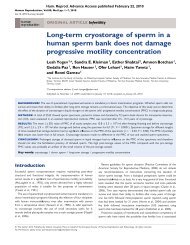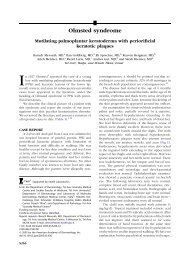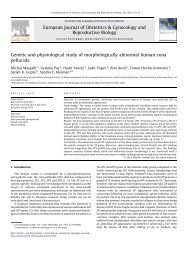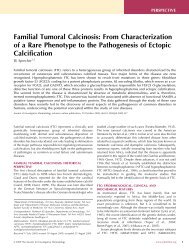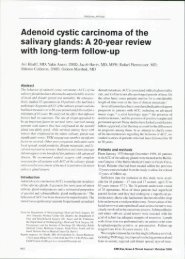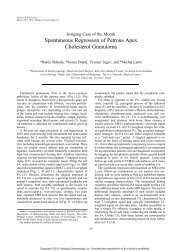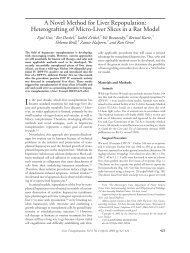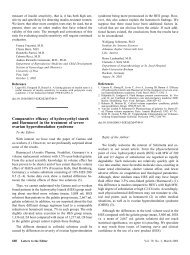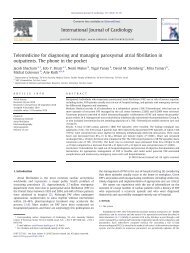Anti-proliferative effects of a novel isoflavone derivative in medullary ...
Anti-proliferative effects of a novel isoflavone derivative in medullary ...
Anti-proliferative effects of a novel isoflavone derivative in medullary ...
You also want an ePaper? Increase the reach of your titles
YUMPU automatically turns print PDFs into web optimized ePapers that Google loves.
258 Y. Greenman et al. / Journal <strong>of</strong> Steroid Biochemistry & Molecular Biology 132 (2012) 256– 261<br />
Fig. 1. Estradiol-17(, ER� and ER� agonists stimulate DNA synthesis and CK activity <strong>in</strong> <strong>medullary</strong> thyroid carc<strong>in</strong>oma cell l<strong>in</strong>e TT. (a) ER� and ER� mRNA expression <strong>in</strong><br />
cultured human TT cells; (b) effect <strong>of</strong> treatment (24 h) with <strong>in</strong>creas<strong>in</strong>g concentrations <strong>of</strong> estradiol-17� (E2) on DNA synthesis, *p < 0.05; (c) effect <strong>of</strong> MPP (ER� antagonist)<br />
and PTHPP (ER� antagonist) on the stimulatory effect <strong>of</strong> E2, DPN (ER� agonist) and PPT (ER� agonist) on DNA synthesis, *p < 0.05; **p < 0.01 for the difference between<br />
hormonal treated and control treated cells; # p < 0.05 for the difference between hormone + antagonist treated and hormonal treated cells; and (d) <strong>effects</strong> <strong>of</strong> raloxifene on E2-,<br />
DPN- and PPT-<strong>in</strong>duced changes <strong>in</strong> CK specific activity, *p < 0.05 for the difference between hormonal treated and control treated cells; # p < 0.05 for the difference between<br />
hormone + Ral treated and hormonal treated cells.<br />
dose-dependent <strong>in</strong>crease <strong>in</strong> DNA synthesis <strong>in</strong> TT cells as assessed by<br />
[ 3 H]-thymid<strong>in</strong>e <strong>in</strong>corporation (Fig. 1b). Stimulation <strong>of</strong> proliferation<br />
occurred even at low concentrations <strong>of</strong> E2, which are equivalent to<br />
physiological E2 levels <strong>in</strong> adult females (0.3–3 nM). The ER� agonist<br />
DPN at low concentration (42 nM) stimulated [ 3 H]-thymid<strong>in</strong>e<br />
<strong>in</strong>corporation by 68% (similar to the extent <strong>of</strong> <strong>in</strong>crease <strong>in</strong> DNA<br />
synthesis achieved with E2 at similar concentration). Incubation<br />
with higher concentrations <strong>of</strong> DPN had no effect on cell proliferation.<br />
In contrast, <strong>in</strong>cubation <strong>of</strong> TT cells with a low concentration<br />
<strong>of</strong> the ER� agonist PPT (39 nM) had no effect, but at higher concentrations<br />
(390 nM) this agent caused a significant stimulation <strong>of</strong><br />
[ 3 H]-thymid<strong>in</strong>e <strong>in</strong>corporation (data not shown). Consequently, all<br />
subsequent experiments as described below were performed us<strong>in</strong>g<br />
DPN concentration <strong>of</strong> 42 nM and PPT concentration <strong>of</strong> 390 nM. The<br />
stimulatory effect <strong>of</strong> E2 (30 nM) on DNA synthesis was attenuated<br />
by co-<strong>in</strong>cubation <strong>of</strong> either the ER� specific antagonist MPP<br />
(150 nM) or the ER� specific antagonist PTHPP (150 nM), <strong>in</strong>dicat<strong>in</strong>g<br />
that the estrogen <strong>in</strong>duced proliferation <strong>in</strong> these cells is mediated by<br />
both ER� and ER� (Fig. 1c). Furthermore, the stimulatory effect <strong>of</strong><br />
the ER� agonist DPN on cell proliferation was more robustly <strong>in</strong>hibited<br />
by co-<strong>in</strong>cubation with the ER� antagonist PTHPP, than with<br />
MPP. Accord<strong>in</strong>gly, ER� mediated DNA synthesis by PPT was mostly<br />
<strong>in</strong>hibited by the specific ER� antagonist MPP (Fig. 1c). Nuclear<br />
receptor-dependent estrogenic activity, as measured by creat<strong>in</strong>e<br />
k<strong>in</strong>ase specific activity (CK activity), was significantly stimulated<br />
by E2 (30 nM), DPN (42 nM) and PPT (390 nM, Fig. 1d). Incubation<br />
with the selective estrogen receptor modulator (SERM) Raloxifene<br />
(Ral, 3 �M) that has tissue specific stimulatory or <strong>in</strong>hibitory activities,<br />
<strong>in</strong>duced CK activity <strong>in</strong> TT cells (Fig. 1d). On the other hand, Ral<br />
blocked E 2 and PPT but not DPN stimulation <strong>of</strong> CK activity, reflect<strong>in</strong>g<br />
its predom<strong>in</strong>ant antagonism <strong>of</strong> ER� over ER� (Fig. 1d). These<br />
results <strong>in</strong>dicate that despite the more pronounced mRNA expression<br />
<strong>of</strong> ER� <strong>in</strong> TT cells, both receptor is<strong>of</strong>orms significantly mediate<br />
E2 <strong>in</strong>duced proliferation <strong>in</strong> these cells.<br />
3.2. Effect <strong>of</strong> cD-tBoc on human TT cell l<strong>in</strong>e growth and survival<br />
<strong>in</strong> vitro<br />
cD-tBoc significantly <strong>in</strong>hibited DNA synthesis <strong>in</strong> cultured TT<br />
cells <strong>in</strong> a dose dependent manner rang<strong>in</strong>g from 0.0312 to 3.120 �M<br />
(Fig. 2a). Similar <strong>in</strong>hibitory <strong>effects</strong> were observed when cell proliferation<br />
was assessed by the XTT assay, with maximal suppression <strong>of</strong><br />
proliferation (70%) achieved at cD-tBoc concentration <strong>of</strong> 0.312 �M<br />
(not shown). Furthermore, cD-tBoc (3.12 �M) completely abrogated<br />
the <strong>proliferative</strong> effect <strong>of</strong> E2, as well as <strong>of</strong> the ER� agonist<br />
DPN, but not <strong>of</strong> the ER� agonist MPP (Fig. 2b). Concordant with<br />
this f<strong>in</strong>d<strong>in</strong>g, the cD-tBoc <strong>in</strong>hibitory effect on [ 3 H]-thymid<strong>in</strong>e <strong>in</strong>corporation<br />
could be blocked by PTHPP (anti-ER�) but not with MPP<br />
(anti-ER�), suggest<strong>in</strong>g that the anti<strong>proliferative</strong> effect <strong>of</strong> cD-tBoc<br />
on these cells is mediated through ER� (Fig. 2c). F<strong>in</strong>ally, basal CK<br />
activity, as well as E2 and DPN (but no PPT) stimulated CK activity<br />
was suppressed by co-treatment with cD-tBoc (Fig. 2d). Fig. 3<br />
depicts actual photographs <strong>of</strong> control and treated TT cells respond<strong>in</strong>g<br />
to this compound. Shown photographs were obta<strong>in</strong>ed follow<strong>in</strong>g<br />
24 h <strong>of</strong> culture with vehicle (Fig. 3a) or with cD-tBoc at 3 (Fig. 3b),<br />
30 (Fig. 3c) and 300 nM (Fig. 3d).<br />
3.3. cD-tBoc <strong>in</strong>duces thyroid cancer cell death through the<br />
<strong>in</strong>duction <strong>of</strong> apoptosis and necrosis<br />
cD-tBoc potently <strong>in</strong>creased apoptosis (1350–1750% stimulation<br />
<strong>of</strong> histone–DNA fragments), with the maximal effect be<strong>in</strong>g




